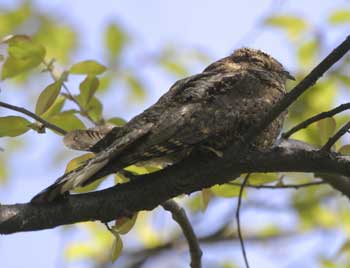
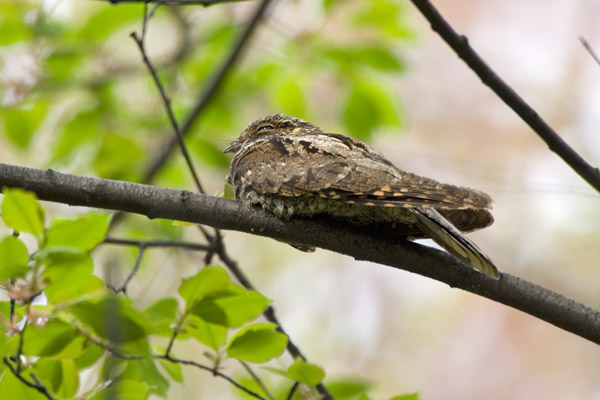
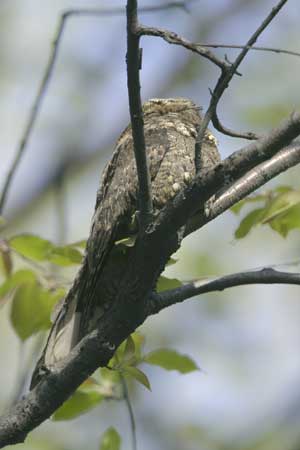
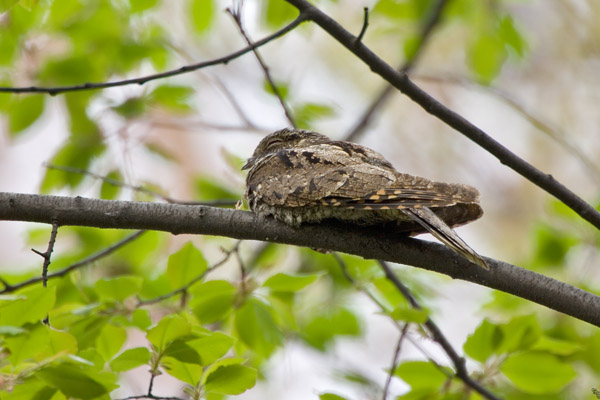

Whip-poor-will and Chuck-will's-widow - Seen From Below
Images and text copyright © Phil Jeffrey 2007-2015, Scott Zevon ©2007 where noted
Based on the original version of this text, I've had helpful input from Karen Fung, Eve Levine and Ben Cacace (nevertheless I welcome more input). This piece remains a work in progress, however, and I've yet to attempt to get a look at skins of each species to get a more detailed impression. I first started writing this text before the split into Eastern and Mexican Whip-poor-will (Antrostomus vociferus and Antrostomus arizonae respectively) but I've modified the text to reflect the new species name.
An Eastern Whip-poor-will was found by Michael Gitlin along the Gill in Central Park on Apr 30th 2007 in a location reminiscent of the 2004 Eastern Whip-poor-will of controversial identity. The 2004 bird was a male, based on the white tips of the retrices (tail feathers) and the 2007 bird was a female based on buffy rather than white tail tips - see Peter Pyle's book "Identification Guide to North American Birds" (for this and more):
| 2004 | 2007 |
|---|---|

|
 |

|
 |
Nevertheless the structure of the two birds are strikingly similar, and the ID is not in question. Rufous barring on the primaries and overall rounded primary shape and tail shape easily eliminate Common Nighthawk - the Nighthawk has uniformly dark primaries which extend to the tip of the tail (Whip and Chuck tails are longer than the primaries on perched birds) and the white mark half way along the folded wing is often pretty obvious in Nighthawks. The discussion tends to center around the discrimination between Eastern Whip-poor-will and the far scarcer Chuck-will's-widow.
Fortunately Andy Guthrie found a Chuck-will's-widow nearby at the Azalea Pond in Central Park just a few days later on May 3rd 2007. This very exciting find was also photographable and below is a picture taken in afternoon light by Scott Zevon (and © him) of this bird:

© Scott Zevon 2007
| Eastern Whip-poor-will | Chuck-will's-widow |
|---|---|
 |
 |
On May 14th 2008 Dick Gershon's group found another Chuck-will's-widow in the park, down the Point, and I was able to get pictures of this one myself. This was also a female as judged from the undertail pattern. This particular bird was seen as much from the side as below. Additionally its relatively large size was immediately evident - and notably larger than an American Robin that perched nearby.
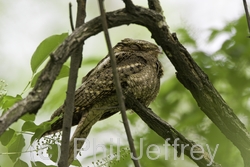
Chuck-will's-widow, female, CPK 2008
David Sibley's field guide, for example, deals mainly with the top-down view of the bird which for non-park birders might be a reasonable pose, but we tend to see them from below. I'm not really enamored of Sibley's representation of these nightjars which to my eye makes them seem too small and dumpy when they look more elongated to me - it makes them look like the diminutive Common Poorwill. The National Geographic book (I have version 3) has poses which are closer to my exprience. One can use images.google.com to form your own impressions.
The 2013 Chuck-will's-widow was more distant but Bruce Yolton has some nice photos showing the undertail, where again it's immediately obvious that it's a Chuck-will's-widow just from the pattern alone. It's also perched across the branch, once more.
Color:
There are various field marks which distinguish between the two birds. The first is the overall color: Chuck-will's-widow averages much buffier, and this is amplified in Scott's shot taken in warm light toward the end of the day and in the 2008 bird from my own photos. While not quite rufous, it's certainly quite a warm shade of brown. Whips more so than Chucks appear to show more color variation, so this is not an absolutely guaranteed field mark although none of the Eastern Whip-poor-wills that I have seen in the North-East have showed much color variation. In photos perceived color is often strongly dependent on the illuminating light (under canopy, fill flash, main flash etc).
Having spent much time looking at the undertails of all these birds, it struck me that the undertail markings are an underappreciated field mark in this context. The undertail of the 2007 and 2008 Chuck-will's-widows are much different to the Eastern Whip-poor-will - instead of large white or buffy tips to the feathers there is a cryptic mottled brown and buff pattern. I saw the 2007 Chuck-will's-widow perform a tail-spread and there was no trace of white on it (ergo, a female) so we don't have is an image of the undertail pattern on a male Chuck-will's-widow. So far I have found no image of this on the internet. However the tips on the Eastern Whip-poor-will's retrices cover the both inner and outer webs while those for the male Chuck-will's-widow supposedly cover only the inner web and the far tip of the feather is dark. This might be obvious if the underside of the tail is studied carefully and in fact in each of the Eastern Whip-poor-wills that I have seen the tail feathers were very obvious and seen clearly to the tips. Eve Levine pointed out that the National Geographic guide has a picture of spread Eastern Whip-poor-will and Chuck-will's-widow from above, which is not exactly what we want but pretty close and reinforces the idea that white/buff tail tips should be seen clearly from below.
In October 2013 I was sent this picture of a Chuck-will's-widow recovered in Panama City, Panama. Thanks to Panama Audubon Society for letting me use it:

Male Chuck-will's-widow, Panama, ©Rosabel Miró R., Panama Audubon Society, all rights reserved.
Apart from anything else look at the size of this bird, which has a wingspan of over 2 feet, but you'll also notice the large white patches on each outer tail feathers and the mottled pattern on the inner four retrices. No black whatseover in that tail.
The black throat pattern which should be present on male Eastern Whip-poor-wills does not seem to be an especially good ID mark from personal experience since it's often not well-resolved when viewing from below the bird and on the 2004 and 2007 Whips it was not prominent. At other angles it might be a usefully definitive ID mark, but there's a risk of a shadow being mistaken for a the black pattern and both species can have white collars.
Size and structure:
With the benefit of seeing the Eastern Whip-poor-will a few days earlier in 2007, the Chuck-will's-widow is a notably chunkier bird - albeit only 20% larger in length the Chuck has a much heftier look about it. This was amply reinforced by the 2008 bird which really showed it's size well. This may not be conveyed well in the photos but the Whip looks close to the size of a Common Nighthawk whereas the Chuck looked considerably bigger. The Chuck-will's-widow clearly has a proportionally much larger and flatter head which is almost half the extent from the bill to the end of the back - this can be seen very obviously from the side-by-side photos where the eye on the Chuck is a long way back on the body because of the sheer extent of the head - in part it's situated there to accommodate a huge mouth. The fact that the tail on this bird is held downwards - and was also held like that periodically on the 2008 Chuck - enhances this impression but nevertheless if it doesn't seem to have a huge head you've got to wonder about identifying it as a Chuck-will's-widow. (See also this picture by Mike Danzenbaker, compared to his Eastern Whip-poor-will shots). The Eastern Whip-poor-will's head is relatively smaller (though by no means small) and rounded. The primary shape is also of some use - the Eastern Whip-poor-will's is relatively rounded whereas the Chuck is relatively pointed (not shown on photo) and in fact on the fly-out at dusk in 2007 this was clearly seen when the bird flew over the top of the canopy in silhouette along with the impressive wing span. On the photos here and also on the web there is a sense that the projection of the bill from the head might also be a secondary ID feature - appearing to be more prominent in Eastern Whip-poor-will - Ben Cacace has disagreed with this point so it's probably best regarded as either highly subjective or entirely spurious.
Voice: they are named after their calls, so the Eastern Whip-poor-will with it's rising last single call note (the Mexican Whip-poor-will in the western USA sings a burrier "purple-rip") is quite distinct from the falling double last note of Chuck-will's-widow. The songs are available as MP3's at the Patuxent site for Eastern Whip-poor-will and Chuck-will's-widow. Xeno-canto is usually an excellent resource for all sorts of bird songs, including nightjars.
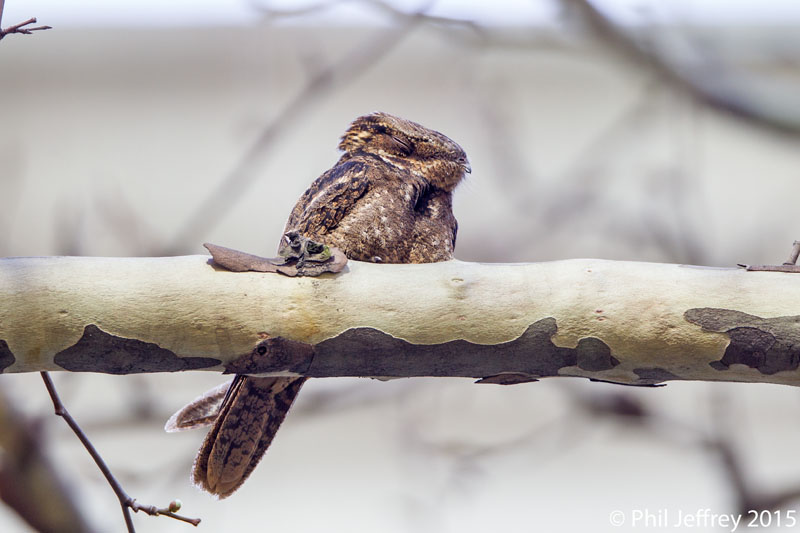
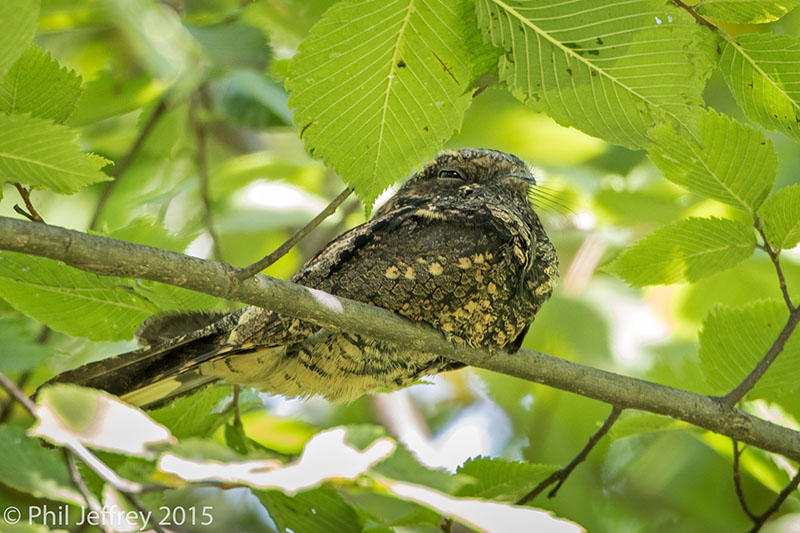
|
 |